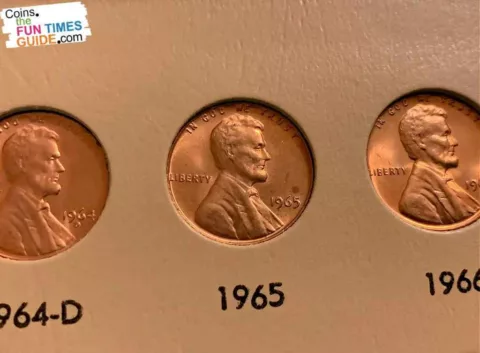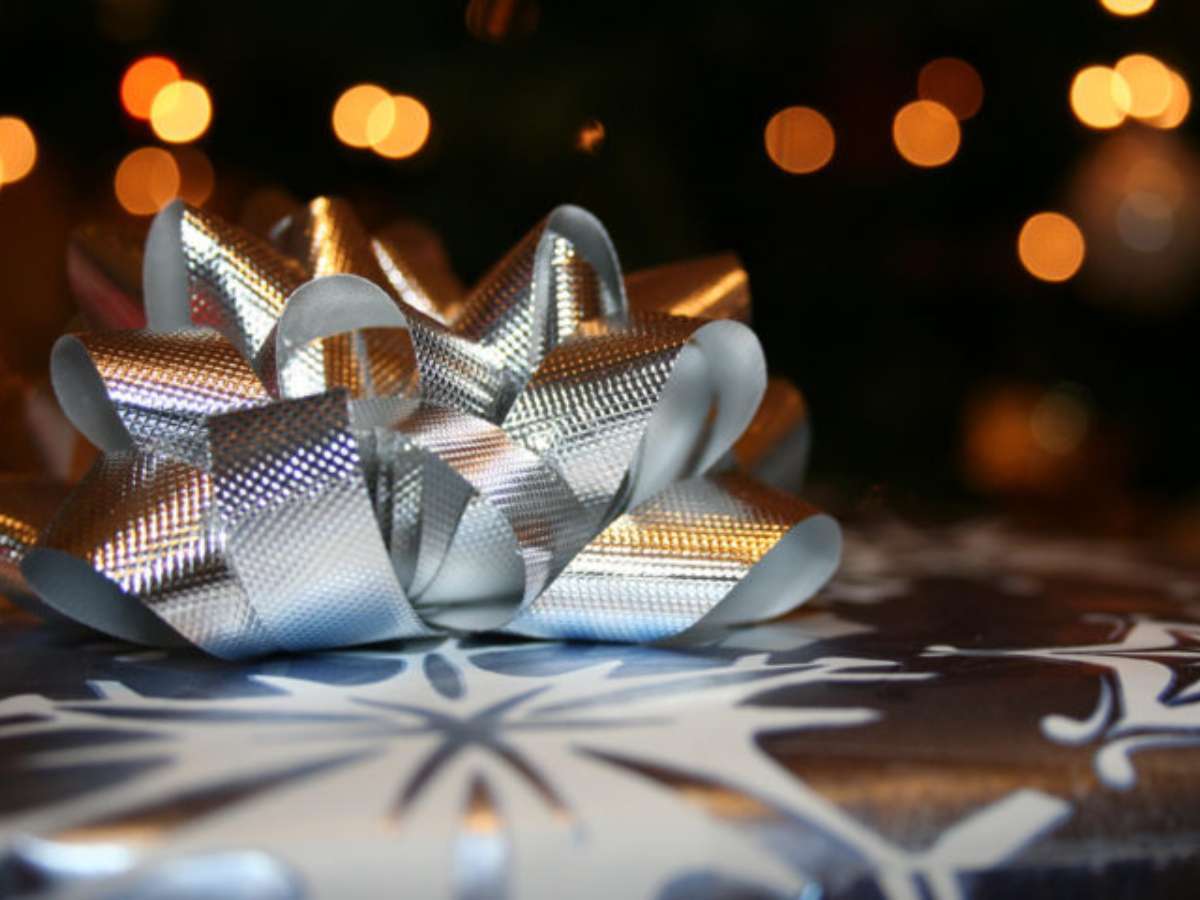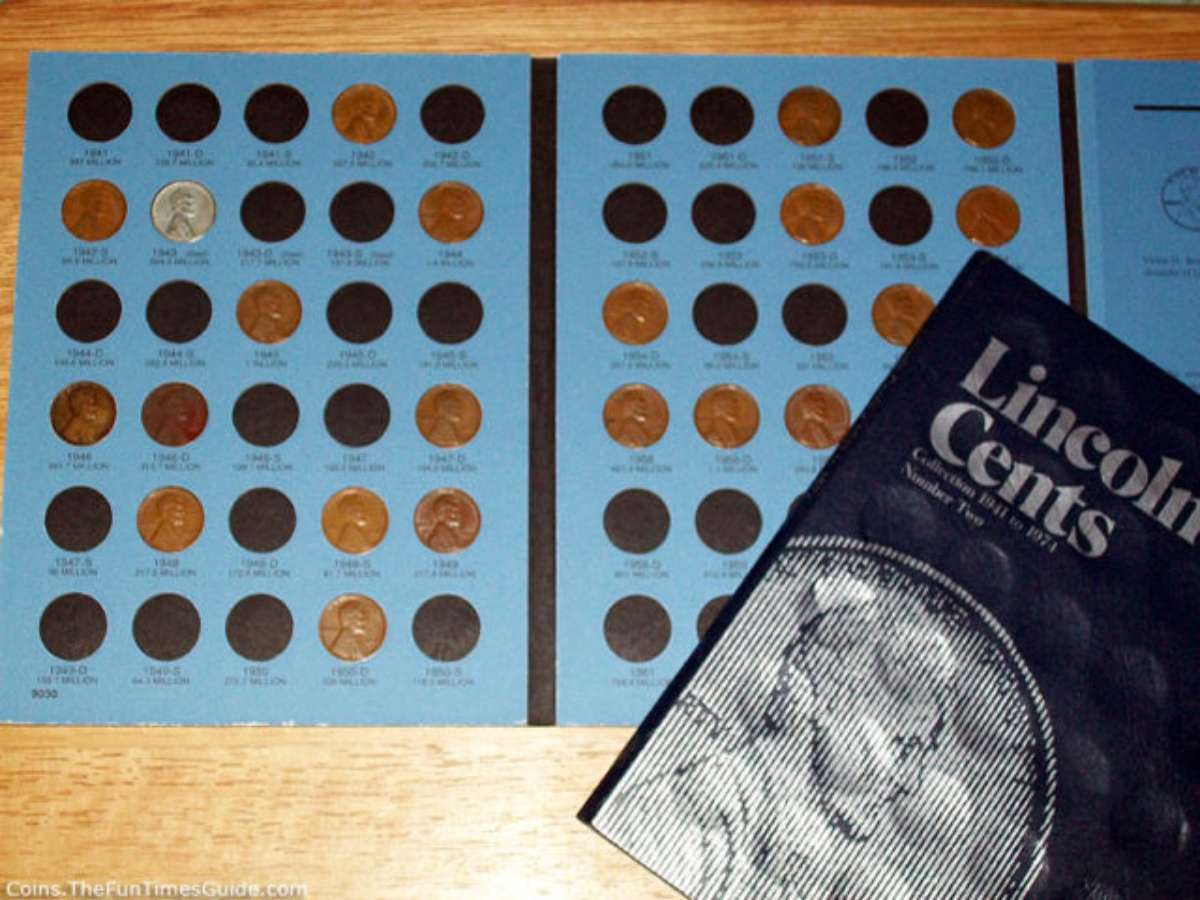
Did you know that all 1965 pennies are worth more than face value?
What’s more… some are worth thousands of dollars!
So, which 1965 pennies — specifically — are the rare and valuable ones?
Find out below…
NOTE: Due to a major coin shortage, the U.S. Mint embarked on multi-year changes to the U.S. coin system in 1965. This entailed eliminating 90% silver coinage from the production lineup and temporarily removing mintmarks from all U.S. coins. Also, no more proof sets or uncirculated sets — these were replaced by Special Mint Sets (SMS).
1965 Penny Value
The 1965 Lincoln Memorial penny had a mintage of 1,497,224,900 and is considered common by many coin collectors.
However, you may have discovered that it’s rather difficult to find 1965 pennies in pocket change. Why is that? It might have something to do with the fact that these old pennies are made from bronze, which in a 1965 penny is a composition of 95% copper, 5% zinc.
Copper is a semi-precious metal, and its value has gone up in recent decades. Today, the amount of copper in a 1965 penny is worth about twice the coin’s face value. So that means all 1965 pennies (even the well-worn ones) are worth around 2 cents apiece.
How much are 1965 pennies in really good condition worth?
Typical 1965 pennies in uncirculated condition are worth 10 to 30 cents apiece. Those that are in exceptionally good condition are worth much more!
The most valuable 1965 penny to ever cross the auction block was graded MS67RB by Professional Coin Grading Service and sold for $690 in a 2012 auction.
1965 SMS Penny Value
In 1965, the U.S. Mint substituted proof sets and uncirculated sets with Special Mint Sets (SMS). These 5-coin sets contain coins with proof-like surfaces.
SMS coins share some qualities with both proof coinage and business-strike (aka circulation strike) pieces:
- While SMS coins generally have shinier surfaces and sharper strikes than typical circulation strikes, they were not struck twice as proof coins are. (They are not in any way proof coins.)
- SMS coins were made with specially prepared blanks and dies, and they also received special handling throughout the process of their manufacture.
- The 1965 SMS pennies were made by the U.S. Mint for distribution only in SMS sets and were not placed into circulation to be spent as money.
A total of 2,360,000 examples of the 1965 SMS penny were made, and they’re easy enough to find in their 1965 Special Mint Sets — which can be bought at almost any coin dealer.
While the sharper strike of the 1965 SMS pennies and their matte finishes look distinctive from circulation issues, it’s extremely difficult to tell if a worn 1965 penny found in circulation was a regular business strike or an SMS strike.
Even if you could tell a worn 1965 SMS penny broken out of its cellophane SMS set packaging from a regular 1965 penny, the circulated special strike really wouldn’t be worth any more than its copper value of about 2 cents. Meanwhile, a typical 1965 SMS Lincoln cent is worth around 50 cents to $1.
The most valuable 1965 SMS penny to ever sell was graded MS67 Red Ultra Cameo by Numismatic Guaranty Corporation. This piece sold for $4,140 in a 2004 auction.
IMPORTANT: What Is The Grade Of Your 1965 Penny?
To determine the true value of your 1965 Lincoln cent, you first need to know what condition (or grade) your coin is in.
Grab a coin magnifier and a copy of the U.S. Coin Grading Standards book. Then, watch this video to see how to grade coins yourself at home:
The best coin grading apps to use when grading coins yourself.
A List Of Rare 1965 Penny Errors And Their Values
Your 1965 penny might be worth significantly more than face value if it has an error or variety!
Here are some of the most significant 1965 penny errors and varieties worth money that you can find in spare change, bank rolls, and elsewhere — plus their current value:
1965 Doubled Die Penny Error
This is one of the most famous types of coin varieties. Most of the rare doubled die coins that people hear about are major doubled dies that are worth hundreds or even thousands of dollars — which is why so many collectors are curious about these error coins!
One of the most important reasons those particular doubled dies are worth so much is because the doubling on those coins is pretty drastic and can be easily seen with the naked eye. This helps to create great demand for such pieces — squeezing the supply and, therefore, raising prices.
While there are no major 1965 doubled die penny errors, there are some minor doubled dies that are still worthy of collecting!
These include pieces in which some of the lettering on the obverse (head’s side) and reverse (tail’s side) are slightly doubled. Many of these minor 1965 doubled die pennies often trade for between $10 and $50 — depending on the magnitude and rarity of the doubled die as well as the condition of the individual coin.
1965 Die Break Penny Error
Have you ever seen a coin with raised lines that shouldn’t be there? If so, you’ve probably encountered a coin with a die crack.
These die cracks (or die breaks) can be quite valuable — especially when they’re large enough.
Since die breaks occur when the die(s) striking a coin show signs of wear and tear through fissures and cracks, these sunken areas of damage on the die transfer onto the coin as raised lines, squiggles, and bumps.
These cracks can get progressively larger from coin to coin as the dies become further damaged. The larger or more numerous the die cracks are, the more collectible it becomes to error coin enthusiasts.
Among the most valuable type of die crack error is the die cud — a coin with a large, flattish bump of raised metal attached to or otherwise involving the rim of the coin.
Values for 1965 die break pennies range from $5 to $10 for one that has small cracks to more than $100 for a full-fledged die cud error.
1965 BIE Penny Error
Lots of people who find an “I” between the letters “B” and “E” on a Lincoln penny think there is some kind of spelling error involved. But that’s simply not the case.
It’s more a matter of an old Lincoln penny with a tiny, vertical die crack that opened up in just that spot on the coin. So, no, that little ridge that looks something like a capital “I” isn’t an intentional goof by a foolhardy mint employee. It’s just another type of die break error that’s unique to Lincoln pennies.
These BIE penny errors are quite collectible among Lincoln penny and error coins enthusiasts. Most 1965 BIE error pennies trade for $5 to $10 apiece.




